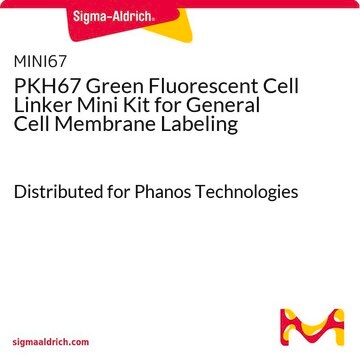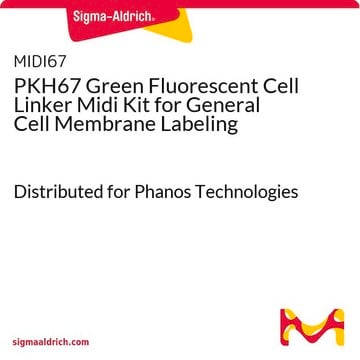The PKH cell linker kits have not been specifically tested for the detection of circulatory fibrocytes. However, there are several publications that indicate suitability. Please see the link below to review one such reference:
https://onlinelibrary.wiley.com/doi/full/10.1111/jcmm.13080
PKH26PCL
PKH26 Red Fluorescent Cell Linker Kit for Phagocytic Cell Labeling
Distributed for Phanos Technologies
Synonyme(s) :
Phagocytic cell label
Sélectionner une taille de conditionnement
1 670,00 €
Sélectionner une taille de conditionnement
About This Item
1 670,00 €
Produits recommandés
Niveau de qualité
Application
Principe
Labeling of phagocytic cells by this methodology may be conducted either in vitro or in vivo. Intraperitoneal or intravenous injections of the PKH26 labeling solution will successfully label phagocytic cells in vivo, while cells of interest which have been isolated may be stained using in vitro labeling methods.
Liaison
Informations légales
Composants de kit seuls
- Diluent B 6 x 10
- PKH26 cell linker in ethanol .5 mL
Produit(s) apparenté(s)
Mention d'avertissement
Danger
Mentions de danger
Conseils de prudence
Classification des risques
Eye Irrit. 2 - Flam. Liq. 2
Code de la classe de stockage
3 - Flammable liquids
Point d'éclair (°F)
57.2 °F - closed cup
Point d'éclair (°C)
14.0 °C - closed cup
Faites votre choix parmi les versions les plus récentes :
Déjà en possession de ce produit ?
Retrouvez la documentation relative aux produits que vous avez récemment achetés dans la Bibliothèque de documents.
Les clients ont également consulté
Articles
PKH dyes are easy to use and achieve stable, uniform, and reproducible fluorescent labeling of live cells. PKH dyes are non-toxic membrane stains which produce high signal to noise ratio.
Lipophilic cell tracking dyes enable cancer biologists to track tumor and immune cell functions both in vitro and in vivo. Read the article to choose a right membrane dye kit for cell tracking and proliferation monitoring.
Optimal staining is a key component for studying tumorigenesis and progression. Learn useful tips and techniques for dye applications, including examples from recent studies.
PKH and CellVue® Fluorescent Cell Linker Kits provide fluorescent labeling of live cells over an extended period of time, with no apparent toxic effects.
-
Is this kit suitable for label circulatory fibrocyte isolated from rat PBMC?
1 réponse-
Utile ?
-
Filtres actifs
Notre équipe de scientifiques dispose d'une expérience dans tous les secteurs de la recherche, notamment en sciences de la vie, science des matériaux, synthèse chimique, chromatographie, analyse et dans de nombreux autres domaines..
Contacter notre Service technique













